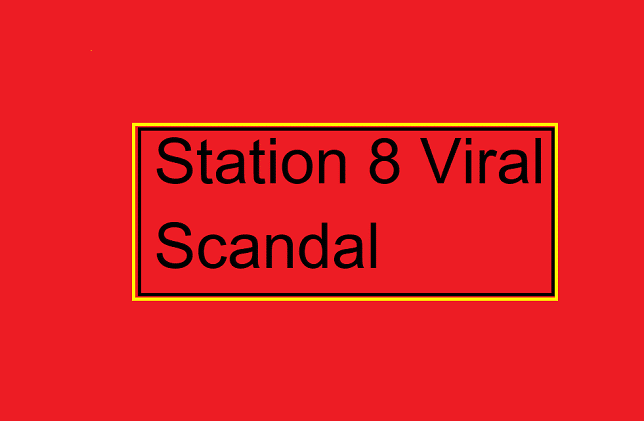Station 8 Viral Scandal: A Complete Overview of the Controversy

In the digital age, viral events can take the world by storm. One such event that has caused significant waves is the “Station 8 viral scandal.” What began as a minor incident rapidly spiraled into a global controversy, captivating audiences from various walks of life. This article will delve into the details of the Station 8 scandal, examining its origins, the events that unfolded, and the aftermath. From the initial shock to the long-lasting impact on public perception, this piece will provide an all-encompassing look at the scandal and its repercussions.
The Origin of the Station 8 Scandal
The Station 8 viral scandal began with a seemingly innocuous video. What looked like an ordinary interaction quickly gained attention after being shared on social media. Like most viral incidents, the video’s contents sparked a heated debate among viewers. The footage captured a controversial moment involving a prominent public figure associated with Station 8, a popular media platform.
Initially posted on a small social media channel, the video spread like wildfire across the internet. Within hours, it had garnered millions of views, and the hashtag #Station8Scandal began trending globally. What made this scandal so explosive wasn’t just the content of the video but the way it highlighted a deeper issue that people were already talking about.
The content of the video sparked an intense debate regarding ethics, privacy, and public accountability, issues particularly sensitive in today’s hyper-connected world. The event quickly became the subject of news outlets, online forums, and social media discussions. Public figures began to weigh in as the controversy gained traction, adding fuel to the fire.
What Happened in the Station 8 Viral Scandal?
To understand the full scale of the scandal, it’s crucial to examine the specifics of the incident. The video that led to the scandal showed a shocking interaction that many viewers deemed inappropriate. It was later revealed that the incident occurred during a live-streamed event hosted by Station 8, a platform known for its digital content and live broadcasts. The content was intended to be light-hearted but instead turned controversial due to the inappropriate nature of the exchange.
The clip showed a person involved in a heated argument with another individual. The altercation quickly escalated and appeared to breach basic standards of civility and respect, leaving many to question the intentions behind the broadcast. Some viewers even accused Station 8 of using shock value to gain attention, while others felt that the individuals involved in the incident were not adequately held accountable.
The Fallout of the Station 8 Scandal
Once the video went viral, the fallout was inevitable. Within hours, public opinion was sharply divided. On one side, some defended Station 8, claiming that the viral video misrepresented the situation. Others felt it indicated larger systemic issues within the platform’s culture.
The scandal triggered a cascade of responses from the platform’s management. Station 8 issued a public statement apologizing for the incident. They claimed to be investigating the matter and promised that the individuals involved would be held accountable for their actions. The apology, however, was met with mixed reactions. Some felt it was sincere, while others believed it was an attempt to save face in the wake of public backlash.
At the same time, the viral nature of the incident only amplified the scandal. The hashtag continued to trend, and soon enough, people worldwide had their say. Discussions regarding accountability, social media ethics, and the power of viral content dominated the conversation. Meanwhile, experts weighed in on the role of digital platforms in moderating content and ensuring ethical standards.
The Role of Social Media in the Scandal
One of the most significant elements of the Station 8 viral scandal was social media’s role in its spread. The internet, particularly platforms like Twitter, Facebook, and TikTok, acted as both the accelerator and amplifier of the controversy. In today’s world, viral content spreads faster than ever, and with the click of a button, an incident can go from being a local issue to a global phenomenon.
The Station 8 viral scandal exemplifies how social media platforms have become the primary battleground for public discourse. Influencers, celebrities, and even regular users all contributed to the conversation, often with strong opinions. Some were quick to condemn the scandal, while others called for more nuanced discussions about the responsibility of digital platforms in preventing such incidents.
In many ways, the scandal acted as a reminder of the power social media holds in shaping public opinion. It also highlighted the need for users and platforms alike to be more mindful of viral content’s consequences on individuals and organizations.
Public Reaction to the Station 8 Scandal
Public reaction to the Station 8 scandal was swift and polarized. On one hand, some expressed outrage at the content of the video. They felt that Station 8 and the people involved had failed to meet the basic standards of professionalism and respect expected from public figures. On the other hand, a vocal group defended the platform, arguing that the scandal was blown out of proportion and that the video was an isolated incident.
As the story continued to unfold, public reaction only intensified. Online petitions were launched, demanding accountability for the individuals involved. Meanwhile, rival platforms capitalized on the controversy, using it as an opportunity to promote their brand of content moderation.
This heightened level of positive and negative engagement demonstrates how viral scandals can capture public attention, leading to larger discussions on social issues and corporate responsibility.
The Aftermath: How Station 8 Recovered
The aftermath of the Station 8 viral scandal was a crucial period for the platform. Station 8’s management faced mounting pressure to address the issue head-on from its users and the broader public. The platform took steps to rebuild its image, which included overhauling its content moderation policies and issuing apologies from key personnel involved in the incident.
Despite these efforts, the scandal left a lasting mark on Station 8’s reputation. The incident was a cautionary tale for other digital platforms needing stronger oversight of live-streamed content and public interactions.
What the Station 8 Scandal Teaches Us
The Station 8 viral scandal offers several lessons for both content creators and users of digital platforms. First, it underscores the power of social media in shaping public perception. Second, it highlights the importance of ethical standards in digital content, especially when dealing with live-streamed events that can quickly spiral out of control.
The most significant takeaway from the scandal is the need for digital platforms to adopt more robust content moderation practices. As more content creators engage with global audiences, it becomes essential for platforms to ensure that their content upholds specific ethical standards to prevent harmful incidents from going viral.
Conclusion
The Station 8 viral scandal is a reminder of the volatile nature of the digital world and the far-reaching impact that viral content can have. From its origins as a seemingly minor video to its status as a global controversy, the scandal has sparked essential discussions about accountability, ethics, and the role of social media in modern society. As we continue to navigate this increasingly interconnected digital landscape, platforms, creators, and users need to be aware of the consequences that come with viral content.




